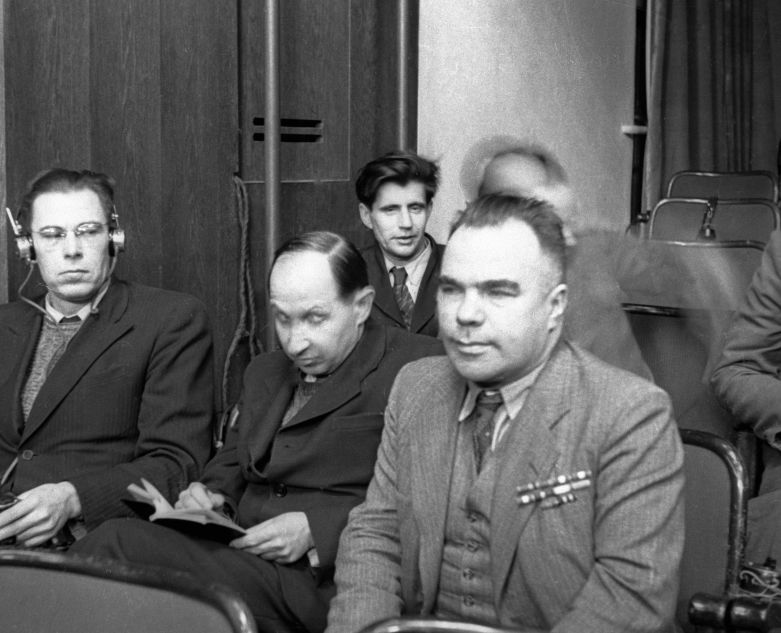In the final month of 1945, the International Military Tribunal was in session for just 15 working days – on 21 December the Court adjourned for the Christmas break. The judges and prosecutors went home; Chief American prosecutor Justice Robert Jackson took advantage of the holidays to see post-war Europe. A long nine months of litigation lay ahead. And the media summed up the start of the Nuremberg Trials.
Fifteen Greedy Palps
“From the start, the Nuremberg courtroom was an impressive backdrop to a giant drama. But last week, with the preliminaries over, the show really got underway. In three days, it reached peaks of comedy, intrigue, and bombast”. (“The Nuremberg Show”, Newsweek No. 50, 10 December 1945).
The hero of “comedy, intrigue, and pomp” was the most important defendant, Hermann Goering. He never ceased to look for causes for amusement. One of these was the demonstration of the evidence of German plans for an aggressive war against its neighbours.
“A map is unfurled on the screen in the courtroom. A grey spider stretches fifteen greedy palps in all directions. And these palps carry the treaties that Germany has violated”. (“Wolves in General's Jackets”, by Ivanov Vsevolod, Izvestia, No. 290, 10 December 1945).
“The moment the British prosecutor recalled the prohibition on Germany having military aircraft, Goering, the former Commander-in-Chief of the Luftwaffe, took off his headphones and laughed. His expression was as if he had just heard a good joke”. ("Le Procès de Nuremberg", Le Monde, 7 December 1945).
‘The Wicked 20 Rushing to the Throne’
“The Nazi Plan”, an American documentary film, made a big impression on the defendants. The footage of the official newsreel tells the story of “how that villainous group of twenty was sneaking to the throne”. The defendants sulked in anticipation of seeing their exploits from the side, correspondent Leonid Leonov wrote in the newspaper Pravda on 20 December.
And then the lights were off – the screening of the film began. Memories of the first Nazi parades and Hitler's rise to power seemed to have excited the defendants.
“…the defendants acted like excited schoolchildren seeing their pictures flashed across the screen. They nodded and nudged one another”. (“Nazis Glory in Film of ‘Good Old Days’” by Tania Long, The New York Times, 12 December 1945).
The film ended with footage of the execution of those involved in the 1944 assassination attempt on Hitler. The contrast between the Nuremberg trials and the "people's court" that the Nazis carried out was striking to viewers.
“The movie, [showing the striking difference between the justice administered to the defendants and the way they behaved], brought back to [the defendants] memories of a vanished era, and some, including Rudolf Hess, were hardly able to restrain themselves from applauding Hitler’s recorded speeches”. (“Nazis Glory in Film of ‘Good Old Days’” by Tania Long, The New York Times, 12 December 1945).
“If Robert Jackson, chief US prosecutor, was shown the entire movie, he would be willing to join the Nazi party himself”, an observer in Courtroom 600 overheard Hermann Goering remark.
The impressions of the rest of the audience were not as enthusiastic. “We also find this film incomplete. It lacks the final shots for historical integrity”, Leonid Leonov, a correspondent for the newspaper Pravda, concluded.
“However, there is hope that by spring the cameramen will have filmed that missing piece with those same actors, performing the verdict of the court”. (“The Shadow of Barbarossa” by Leonid Leonov, Pravda, 20 December 1945).
‘Ghosts of Murdered Victims Crowded Courtroom 600’
The documentary evidence of the atrocities was so overwhelming that scenes of civilian executions seemed to unfold right in the courtroom.
“The longer you listen to these documents, the harder to bear it gets. You see our villages being burned down, you hear the cries of children being shot and parents executed, whom Hitler's slave masters have declared their hostages”, “On Hitler’s Forced Labour” by Vsevolod Vishnevsky, Pravda, 15 December 1945.
"The egregious records evoked in the minds of those present the images of the victims whose ghosts had gathered in Courtroom 600 to bear witness to the retribution unleashed against their executioners”. "(...) I want to speak now about those not present at the trial, but who are invisibly present in the courtroom all the time, who grimly stand behind the judges and listen in silence to the reading of more and more horrific documents about the slave labour introduced by the Nazis, about the evil Nazi plot against all humanity, who silently cry out for harshness and demand vengeance”. (“Cry no more, Maria!” by Boris Polevoi, Pravda, 13 December 1945.)
“Are there just eight judges sitting in the judgement? No. In the Nuremberg courtroom are my brothers and sisters, prisoners of war who were starved to death, children suffocated in murder vans, the shadows of Maidanek, Oswiecim [Auschwitz], Treblinka, the blood of hostages, the ashes of Russian towns, and the black wounds of Leningrad. All humanity and every man are sitting in judgement”. (“History’s Morality – The Nuremberg Trial” by Ilya Ehrenburg, Izvestia, 1 December 1945).
Prepared by Vasilina Vartsaba
























